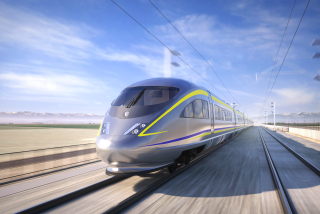Efforts Begin to Save Threatened Projects
- Share via
Like runners elbowing for position at the starting line, local officials began the political jockeying Thursday to preserve long promised but now threatened rail lines to their region.
“We haven’t lost yet,” said Monrovia Mayor Bob Bartlett, who is faced with the prospect of having to wait 20 years or longer for a rail line to reach his community. “What we should do is get business and industry . . . involved and maybe help fund the darn thing.”
County Supervisor Yvonne Brathwaite Burke said she will continue to push for a line running through the Crenshaw district. And Supervisor Mike Antonovich suggested replacing portions of a proposed subway with less costly aboveground rail to free funds for more rail lines--including one in Burbank and Glendale.
The scramble among politicians to save their transit projects was set off by a Metropolitan Transportation Authority proposal that drastically scales down plans for a rail system to 95 miles to be built over the next two decades.
The MTA had previously proposed building 225 miles of rail projects over the next 30 years, but transit officials have said the recession and voter rejection of rail bond measures have forced them to scale back their plans.
The proposed $65-billion plan, which must be approved by the MTA board, also calls for buying 300 buses--fewer than planned--and building 220 miles of car-pool lanes on freeways over the next two decades.
The plan would concentrate rail construction around a handful of projects: a Downtown Los Angeles to Pasadena rail line, the extension of the subway system to the Westside and Eastside, and rail across the San Fernando Valley as far as the San Diego Freeway.
Gone are a host of candidates for new rail corridors, such as proposed lines through the Crenshaw district in South-Central Los Angeles; from Downtown Los Angeles to Burbank and Glendale; down Exposition Boulevard from USC to Santa Monica; from Pasadena to Azusa or Irwindale, and extensions of the Green Line from El Segundo to Torrance and Westchester.
Los Angeles City Councilwoman Ruth Galanter said she spent a lot of time negotiating with a property owner to buy land for the Green Line extension to Westchester.
“Now the property owner and I are frustrated that it’s not going to happen,” she said.
But even backers of the lines that escaped the budget ax were cautious.
“We do not consider our project out of jeopardy at this point even with the smaller plan,” said Robert Huddy, chairman of the Pasadena Transportation Commission, where a planned $1-billion rail line due for completion in 2002 is one of the few projects spared. “We’re very concerned about the cost escalation (on the project) and the failure of cost controls.”
Antonovich, who heads the MTA board, said he is exploring new technology in an effort to keep alive two rail projects that would serve his district, the Los Angeles-Burbank-Glendale line and the San Gabriel Valley line.
The supervisor saw the new plan as an opportunity to question why rail projects in other parts of the county should suffer while the subway, “like the fat lady with a box of chocolates consumes all of the resources available for transit systems.”
“The new fiscal realities will require that the members of the MTA rethink the modes of transportation to be used,” Antonovich said.
Burke said she remains very optimistic that the Crenshaw line would be restored to the plan.
“We’re kind of the hole in the doughnut,” she said, referring to transit lines that encircle the Crenshaw area.
Los Angeles City Councilman Richard Alatorre, an MTA board member, said he is not willing to support the 20-year plan because he wants the MTA to consider restoring all the rail line proposals that have been discarded--even without immediate sources of funding available.
“We have made commitments, and we have to live up to those commitments,” Alatorre said. “I don’t know if we can restore all of (the rail lines), but we have to be more aggressive and begin to spend more time trying to (find) money. . . . I don’t think we should give up on anything.”
But Supervisor Zev Yaroslavsky, another MTA board member, said: “We can always expand our program when the funds are there. But we should not be putting together a Christmas tree of rail lines. . . . The one way to lose public support for the rail program is to have lines that are partially complete.”
“There’s a lot of disappointment,” said Phyllis E. Papen, mayor of Diamond Bar, “but we were promised more than could be reasonably delivered.”
Times staff writers Jeff Kass, Richard Simon and Eric Lichtblau contributed to this story.
More to Read
Sign up for Essential California
The most important California stories and recommendations in your inbox every morning.
You may occasionally receive promotional content from the Los Angeles Times.













